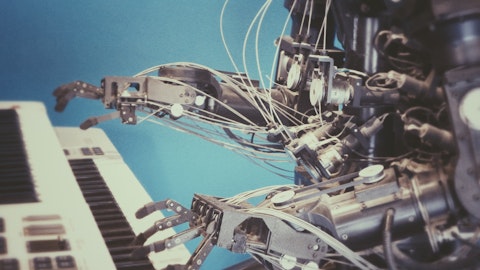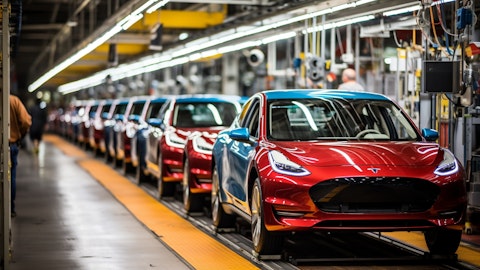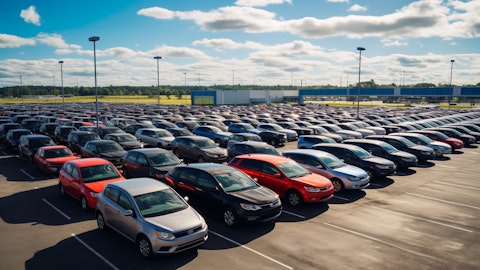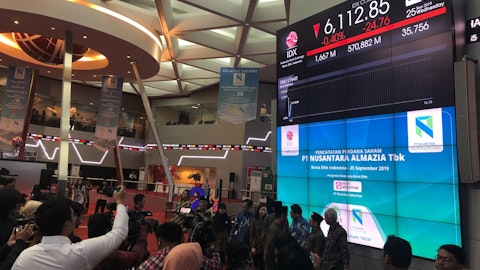SES AI Corporation (NYSE:SES) Q1 2024 Earnings Call Transcript May 3, 2024
SES AI Corporation isn’t one of the 30 most popular stocks among hedge funds at the end of the third quarter (see the details here).
Operator: Good morning, all. I would like to welcome you all to the SES First Quarter 2024 Business and Financial Results Call. My name is Brica and I will be your moderator for today’s call. All lines are on mute for the presentation portion of the call with an opportunity for questions-and-answers at the end. [Operator Instructions]. Thank you. I would now like to pass the conference over to your host, Kyle Pilkington, Chief Legal Officer to begin. So, Kyle, please go ahead.
Kyle Pilkington: Hello everyone, and welcome to our conference call covering our first quarter 2024 results. Joining me today are Qichao Hu, Founder and Chief Executive Officer; and Jing Nealis, Chief Financial Officer. We issued our shareholder letter just after 4 PM yesterday, which provides a business update as well as our financial results. You’ll find a press release with a link to our shareholder letter and today’s conference call webcast in the Investor Relations section of our website at ses.ai. Before we get started, this is a reminder that the discussion today may contain forward-looking information or forward-looking statements within the meaning of applicable securities legislation. These statements are based on our predictions and expectations as of today.
Such statements can involve certain risks, assumptions and uncertainties, which may cause our actual or future results and performance to be materially different from those expressed or implied in these statements. The risks and uncertainties that could cause our results to differ materially from our current expectations include, but are not limited to, those detailed in our latest earnings release and in our SEC filings. This morning, we will review our business as well as the results for the quarter. With that, I’ll pass it over to Qichao.
Qichao Hu: Good morning and thank you for joining us on our call. Our mission is to power a new era of electric transportation on land and in the air with Lithium-Metal batteries. That new era became a lot more visible in the past few weeks as we reached two significant milestones that we believe no other Lithium-Metal battery manufacturer has ever reached before. We’re excited to talk about these achievements in more detail today as we believe the milestones reinforce our lead in the race to commercialize our Lithium-Metal technology for both EV and UAM applications. I want our time this morning to center on how we got to this point and what it means for SES AI going forward. We have talked about four pillars in the business that support our vision and we have made significant advancements in each one this year.
Let’s talk about our core focus first, EV. We have an extremely differentiated high-density battery technology platform that has been validated by JDA partners such as Hyundai, Honda, and GM. Our announcement last week that the JDA partnership with Hyundai is entering the next phase further validates our technology and capability to scale manufacturing to rapidly meet increased demand. This agreement represents two global firsts for SES AI and our industry. It is the first time a Lithium-Metal battery manufacturer is building a line within an automotive OEM’s facility, and it makes us the only Lithium-Metal battery company to have two B-sample development JDAs underway. In the past few months, we have all seen coverage about how OEMs in the U.S. are scaling back their EV ambitions.
However, Hyundai, already the second-largest EV manufacturer in the United States, is focusing on becoming a Top 3 global EV maker by 2030. They recently announced a $50 plus billion investment to increase their EV lineup to 31 models and additional personnel for research and development of new EVs and batteries. Honda announced last week that they are making a $15 billion investment in EV plants in Canada, reinforcing their commitment to very ambitious goals over the next decade. I can’t emphasize enough the significance of moving into the next phase of our joint development contract with Hyundai, and the confidence Hyundai has placed in SES AI’s technology and capabilities. While Hyundai will fund the development of the dedicated B-sample facility in their Electrification Research Center in Uiwang, South Korea, SES AI will be investing in building and operating one of the largest capacity Lithium-Metal lines in the world within this new facility.
We expect this line to be ready early in the fourth quarter of this year with our Avatar AI infrastructure ready several months thereafter. The increased production allows for more training of our Avatar AI in addition to more testing. The testing we will be conducting will be on the performance life cycle. We will test the cells to the extreme to understand where they fail. This process is similar to what we are doing under our other B-sample agreement. Operating this B-sample line in Hyundai’s Uiwang facility will be good practice for what we plan to do with C-samples and beyond, especially with the joint ventures we’ve mentioned in the past that we believe can help us support the large scale needed for start of production. Second UAM, while EV is the core focus, we are very committed to Urban Air Mobility, or UAM, as an exciting application for our Lithium-Metal batteries.
It’s the second pillar to our mission. UAM is an adjacent growth opportunity that requires little additional development beyond what we are already doing for EVs, and we believe it is a perfect fit for Lithium-Metal. When I say a little additional development, I mean that the B-sample cells we have delivered for EV are nearly equivalent to commercial production for UAM. With two B-sample agreements going, we can apply those learnings to UAM. UAM operates on a fleet model where revenue per passenger per mile is the primary metric and weight is a primary concern. Lithium-Metal’s energy density means that aircraft can carry twice the number of passengers or double the amount of cargo or double the number of miles. This step-change greatly improves UAM operators’ profitability.
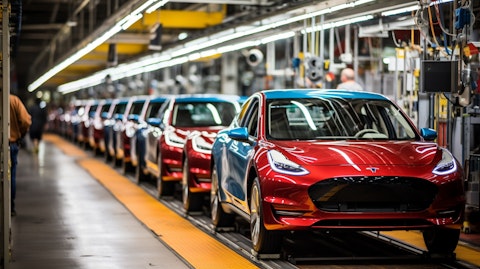
As a first mover in the space, it also means we have an opportunity to make this market. We’re already seeing strong demand from OEMs and have a growing number of cell sampling and supply agreements with the top five OEMs. I would also note that our partner, Hyundai has been very aggressive and has demonstrated commitment to UAM. We have already started work on converting our EV A-sample line in Korea to a UAM-dedicated line, which we expect to complete in September. Third, AI, to ensure practical safety across all our product lines, especially as we prepare for C-Sample and commercial deployment, we have significantly expanded the use of Avatar AI to monitor battery health and predict incidents. Our Lithium-Metal large cell Avatar AI prediction accuracy increased from just 60% in 2022 to 92% last year.
Our target is 95% accuracy by year-end. Ultimately, we aim to achieve a near 100% safety guarantee for EV and UAM and pioneer the foundation for using AI for future road map electrolyte development. With Avatar AI, we are building more than just a battery company. We are laying out a superintelligent AI for electric transportation. Our new Electrolyte Foundry is now fully operational, and we can test new ideas generated by both humans and AI much faster. We are curating several large molecular databases and systematically screening them using both classical physics simulation and machine learning. The goal is to map the relevant small molecular universe. We are very excited to collaborate with several leading research groups on both computing power and machine learning tools.
AI for Science is the future of material discovery and SES AI integrates the world’s leading machine learning scientists, battery domain experts, and an advanced chemical synthesis and cell testing facility. This gives us an ability to innovate and improve our products for EV and UAM at a pace that we believe is unprecedented in the industry. Fourth, sustainability. Lastly, we are integrating sustainability into our operations and innovation to enable supply chain efficiencies to accelerate production timelines and reduce costs. We recently announced that we will fund a new research initiative at Worcester Polytechnic Institute, WPI, to develop state-of-the-art recycling technology for Lithium-Metal. To date, recycling for lithium-ion batteries exists at an early stage but recycling technology for Lithium-Metal batteries has not yet been developed.
Recycling Lithium-Metal batteries can be critical in the reduction of the shortage of raw materials and environmental problems. Another initiative we are pursuing is working on dry electrodes that can reduce chemical solvent evaporation. We expect to announce a collaboration partner on this effort in the not-too-distant future. In a real-time example of integrating environmental efforts into our business, we recently announced SES Cares. This initiative partners with organizations that monitor forest fires and protect marine animals to power advanced drones with our Lithium-Metal A and B-sample cells and collect field data to train Avatar AI. We will have more details on this initiative and our much broader sustainability strategy when we post our first sustainability report at the end of May.
2024 Goals. We noted last quarter that 2024 will be a key year in the commercialization of Lithium-Metal batteries and we’re very pleased with the execution so far on our annual goals. We have become the worlds’ first Lithium-Metal battery manufacturer to have two B-samples underway and we expect to become the first to build a line within an OEM’s facility. With Avatar AI, we expect to produce the highest number of cells this year, with a higher number of associated quality checks than ever before. This increase in data will help to improve Avatar AI’s accuracy. As we look to accelerate future electrolyte discoveries, we are also training and developing new AI models and testing new ideas generated by these models in our Electrolyte Foundry.
I’ll now turn over to Jing for a brief discussion of our financials.
Jing Nealis: Thank you, Qichao. Good afternoon, everyone. Today, I will cover our first quarter 2024 financial results and discuss our operating and capital budget for full-year 2024. In the first quarter, our GAAP operating expenses were $21.3 million, which included $4.8 million of stock-based compensation expense. Cash used in operations was $9 million as we received a $11 million payment from our OEM partners. Capital expenditures were $6.8 million. We ended the first quarter with $319 million in liquidity. Our strong balance sheet will support the company as we stay on track to achieve our commercialization milestones. For the full-year 2024, our financial guidance is unchanged. We continue to expect cash usage from operations to be in the range of $90 million to $100 million and capital expenditures in the range of $20 million to $30 million.
We expect total cash usage for the year in the range of $110 million to $130 million. As we continue to achieve the milestones we laid out, deepen our longstanding partnership with our OEM partners, and accelerate the speed of future electrolyte discovery, we are very focused on capital efficiency. Our priorities for 2024 are to attract top talent to support the strategic goals Qichao laid out earlier, build production capacities to deliver Li-Metal cells to our EV and UAM partners, and advance the use of AI for battery performance prediction as well as electrolyte material discovery as we stay at the forefront of battery material science innovation. With that, I will hand the call back to the operator to open up for questions.
See also 15 Most Competitive Countries in Europe and 15 African Countries with the Lowest English Proficiency.
Q&A Session
Follow Ses Ai Corp (NYSE:SES)
Follow Ses Ai Corp (NYSE:SES)
Receive real-time insider trading and news alerts
Operator: Thank you. [Operator Instructions]. We have the first question from Jed Dorsheimer from William Blair. The line is open.
Mark Shooter: Hi, everyone. You have Mark Shooter on for Jed. Congrats again on the B-sample JDA with Hyundai. I wanted to see if there was any differences between the partnership that you see? Because with Hyundai, you’re going to be in their facility that’s different with the other OEM you’re working with. So could you give us a little color on the compare and contrast those two relationships and any differences you might see between them?
Qichao Hu: Yes, Mark. So the two are similar in terms of production capacity and then also the final specs. And they’re different in the following ways. One is the Hyundai wants is in their facility. So especially when it comes to installing Avatar AI, so you have to install that on their IT infrastructure. That does create some complexity compared to the other one where we do everything on our own infrastructure. So this is one issue we’re still trying to sort out. And this Avatar AI basically has to do with quality, with equipment, with all the data in every process, every step of the entire assembly. So this is probably the biggest difference that we have, this Avatar AI just on someone else’s IT infrastructure. And then — and also for this one, we do plan to build cells primarily for EV, but also Hyundai is interested in UAM, so we’re also testing some higher power density versions of these lithium metal cells for UAM applications whereas the other one is all focused on EV applications.
Mark Shooter: Got it. Okay, thanks for the color. And maybe one for Jing, now that we’re in someone else’s facility, right, do you believe that that helps any with the CapEx spending? I know Hyundai is going to be pitching in for a decent amount of that. So how does that affect the financials? And does this give you any more runway than you were previously expecting?
Jing Nealis: Thanks, Mark. The CapEx and OpEx that we — the guidance we have given out already taken that into consideration, so operating in Hyundai facility definitely helps as the facility cost and everything will be on their side, so it will not increase our total spending this year and it’s fully built into our model.
Mark Shooter: Great. Thanks. I’ll hop back in queue.
Operator: Thank you. [Operator Instructions]. Your next question comes from Shawn Severson of Water Tower Research.
Shawn Severson: Thank you. Good morning. Qichao, I was wondering if we could step back and take a bigger picture question here and it’s regarding the adoption curve of lithium metal. So if we look at kind of what’s going on in the industry, talking about overall EV slowing, but hybrids are doing well, for example. What I’m trying to understand as you start to commercialize in this, the adoption curve of lithium metal versus lithium-ion and the relevancy or how important actual large growth in unit sales, let’s say, are in the EV market. So I guess, to summarize, are you really looking at an adoption curve that provides a great growth curve for you regardless of, let’s say a flattening out of the curve — growth curve for EVs? Am I thinking about it at the right way?
Qichao Hu: Yes, I think if you look at EV today, it’s probably flattening out a little bit for lithium-ion because lithium-ion has saturated a lot in some markets. For example, in China, it’s almost 30%, and then in some countries, in Europe, it’s also more than 20%. So lithium-ion has saturated a lot. But then for lithium metal, it’s still a huge market and then it’s growing really fast. And then UAM, we actually think UAM will see adoption much sooner for lithium metal technologies because of the light weight and also the enhanced safety with Avatar AI. So, now we don’t see any flattening or anything in terms of demand and adoption for new technologies.
Shawn Severson: Right. So even in that flattening unit EV market, you would still see a pretty good pathway, let’s say through of course ’24, but more importantly ’25, ’26, as I assume you would get on more platforms and more commercialization. You’d still be seeing a lot of unit growth because of lithium metal adoption, not necessarily the overall EV market?
Qichao Hu: Yes, yes. I mean, the overall EV market in some countries are at 20%, 30%. So it might be slowing down a little bit. But then for lithium metal, when you are less than 1%, like zero point something, it’s still incredibly fast.
Shawn Severson: Understood. And my next question is about your cash management. As you look into the year in 2024 and beyond, I’m trying to get an understanding of what you would see as optimal capital management in a sense that what do you have to spend versus what are optional spends do you think if we look at cash conservation for 2024 and into 2025? I mean, is it possible you could reduce that more if need be or how flexible are you on that cash budget and spend?
Qichao Hu: Yes, I’ll answer that first. So I think the two B-sample, JDAs, right, those we’ve made commitments. So definitely we want to install the lines, the B-sample lines. And then these are very helpful for us to make more sales and for us more sales meaning more data. So the two B-sample lines, we definitely plan to invest. And then for UAM, UAM, we plan to convert one of the older lines. So instead of buying and building an entirely new line for UAM, we’re not doing that. We are actually converting an old A-sample line to build UAM to save costs. And also, a third area is actually in AI. I think AI, we definitely want to spend it. And then training these AI models cost a lot of compute power. And then — and this is again that the only way to win is basically by having sufficient compute power.
